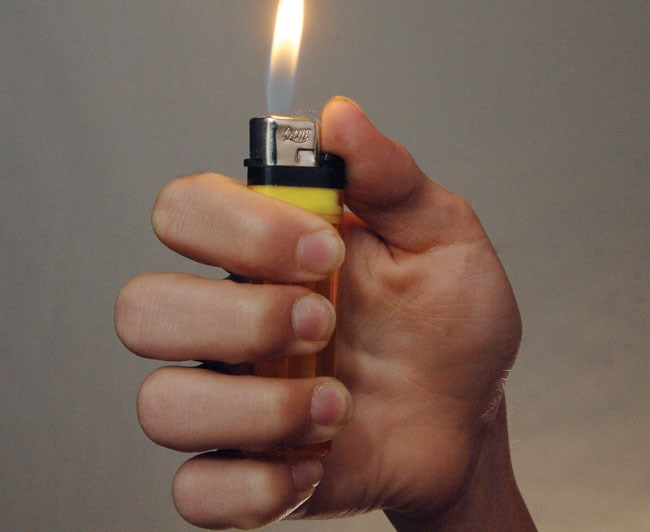Putting out fires can sometimes be done before there is even a spark of interest.
Children often have a light in their eyes at the thought of fire. It's a normal human fascination at any age, known to anyone who has ever caught themselves mesmerized by a campfire or under the spell of a flickering candle.
Local fire officials know from experience that this common interest can turn disastrous, even deadly, in young hands. Programs and resources are locally available to snuff out the urge children and teenagers sometimes have to play with fire.
Like most fire-related issues, the first step is a call to the Prince George Fire Department where a fire prevention officer like Marcel Profeit is ready for such inquiries.
"You don't have to wait for something to happen, but we typically get called upon when someone has set a fire," fire prevention officer Marcel Profeit said. Even if our crews get called to a fire and we know a child started it, it still needs parent or guardian approval to move ahead into an intervention program."
Schools can also order a youth to attend the program as a condition of returning from a suspension
"Our main purpose is to inform, educate," Profeit said. "Most of the time the fire-starting is based in curiosity and the fire-starter hasn't realized the possible consequences, the danger it puts the public in, the dangers it puts firefighters in, the legal consequences, the pain it can cause...
We try not to scare the kids. We also don't want it to feel like a field trip from school. This is a serious thing, the kids are here to learn something important and we treat it as an education experience."
Class has been in session a number of times. Profeit estimated that more than 30 kids have taken the program in the past four years. The typical age is 10 to 12, he said, but some were as young as five and as old as 18.
Broader statistics recorded by the fireproofchildren.com website had an estimated 14,500 fires in the United States in 2006 were set by children, killing 130 people, injuring 810 others, and causing direct property damage of about $328 million.
The same website quoted a University College of the Fraser Valley study disclosing that in the test-market (Surrey), more than 80 per cent of girls and 88 per cent of boys had played with fire by the time they were in high school. Furthermore, according to the website, a 2005 study of almost 4,000 adolescents in grades 7 to 12 in Ontario found that two-thirds reported having played with fire in their lifetimes, and nearly a third reported setting fires during the past 12 months.
While most are simple incidents of curiosity that burned too brightly, some go beyond what the education program at the fire hall can burn into the average child's mind.
When more complex fire-setting cases are presented to fire information officers, they call in help.
"A whole bomb could be going off in their life," said Camille Colbert, a youth mental health and addictions counsellor with Northern Health and a longtime firefighter. She specializes in fire-starters.
"These kids are using fire setting as a coping mechanism and it can get to the point of arson, but most don't. But the power, the consequence of fire can be devastating. It can do damage, injuries, even kill. The kids don't usually understand how profound these consequences can be, because they don't comprehend the fire getting away. When they light a bit of grass or some paper in a garbage can, they expect to put it out or watch it burn out. Being educated about how fire spreads, the speed it spreads, the power it has is a big part of the education."
When a family does bring a child in to the fire hall for the education program, there is a built-in evaluation component so the root of the child's fire fascination can emerge, and they can be directed to the best suited element of the program.
"I have never been contacted for a repeat child," said Profeit. "That may mean they chose to not take part any further, or chose to go somewhere else for the help they need. I'd like to think it's because the program is effective.
"The majority are just minor but we don't distinguish," he added. "A fire is a fire and can potentially be disastrous. In my experience, it is mostly done outdoors and mostly at or near school. Peer pressure can come into it," and that can add deeper levels of danger like intentional vandalism, touching flame to clothing, using accelerants and so on.
"It's about keeping your children safe, your home safe, and your community safe," Colbert said. "We know from statistics compiled over the years that the success rate is about 90 per cent for not lighting further fires once they have the education component. But we don't take it for granted that every kid is going to get it the first time."
Several partner agencies are involved in helping the program. For more information at home, the B.C. Fire Commissioner's Office has a website with a complete manual on the subject of juvenile fire-setting. Find it under their Public Education folder.
"A lot of people don't know the program is there," said Profeit. "Call us, please. It doesn't even have to be an incident-driven thing, just an interest in teaching your kids safety. The fire prevention branch is there to educate and promote safety."
Call 250-561-7667 and ask for the Fire Prevention Office.



